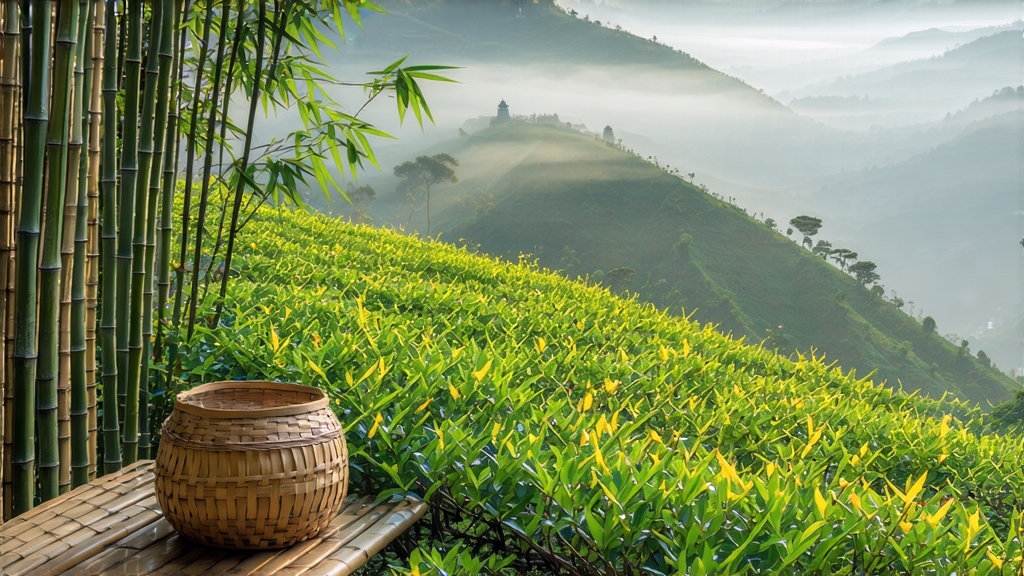
Tucked away in the mist-crowned peaks of Sichuan’s Meng Ding Shan, Meng Ding Huang Ya—literally “Meng Summit Yellow Bud”—has been whispering its mellow secrets for more than twelve centuries. While dragon-well green and da-hong-pao oolong travel the globe as celebrity teas, this yellow-gold gem remains a quiet aristocrat, prized by Song-dynasty emperors, traded along the Tea-Horse Road, then nearly lost during the twentieth-century wars. Today only a handful of families still master the exact “sealed yellowing” that turns a spring bud from green to topaz, making every kilogram a time capsule of Chinese restraint and refinement.
History: from tribute to obscurity
The first written record appears in 808 CE, when Tang scholar Li Zhao listed “Meng Shan stone-flower” as one of the emperor’s ten mandated tributes. By the Northern Song (960-1127) the buds were wrapped in silk, cushioned in bamboo tubes, and rushed 1,500 km to Bianjing along post-horse relays; any leaf that arrived brown was rejected, so the tea became synonymous with impossible freshness. Ming tax reforms shifted tribute to cheaper Zhejiang greens, and Meng Ding Huang Ya retreated into monastic circles where monks prized its low astringency for all-night meditation. Only in 1959 did the Sichuan government revive the craft, selecting 300 mu of heritage gardens at exactly 1,450 m elevation to protect the micro-climate that gives the tea its orchid-chestnut signature.
Terroir: why the mountain matters
Meng Ding Shan sits at the junction of the Tibetan Plateau and the Sichuan Basin; warm wet air rises, cools, and condenses into a 280-day-per-year fog. The cloud curtain filters UV, forcing the tea bush to synthesize more theanine and fewer bitter catechins. At the same time the night temperature can drop 10 °C, locking in floral volatiles. Soils are Devonian sandstone rich in potassium and rare earths, giving the finished liquor a shimmering “golden ring” that professional cuppers use as a first authenticity check.
Raw material: one bud, one leaf, before Qingming
Harvest begins around March 20, when the plateau winter finally loosens its grip. Pickers climb bamboo ladders before dawn, selecting only the standard “one bud, one leaf still half-closed” that measures 18–22 mm. A skilled plucker gathers just 400 g per hour; 50,000 such sets yield 1 kg of finished tea. Any later and the leaf unfurls, ruining the needle silhouette and the delicate protein-sugar balance required for successful yellowing.
Craft: the five steps that create “living gold”
- Sha-qing (kill-green): 160 °C on a cast-iron wok for 90 seconds, enough to halt oxidation enzymes yet keep 12 % residual moisture.
- Re-hong (primary roll): light twisting under palm pressure for 4 minutes; cell breakage is kept below 30 % to avoid grassy notes.
- Men-huang (sealed yellowing): the hallmark of yellow tea. The warm leaf is piled 8 cm deep inside linen bags, then tucked into a pine-wood box lined with wet rice paper. Held at 34 °C and 75 % RH for 48 hours, the leaf slowly re-absorbs its own condensed vapors, turning from jade to straw to antique gold. During this “micro-fermentation” chlorophyll degrades into pheophytin, catechins dimerize, and a rare cyclohexenone called “megastigmatrienone” emerges—chemists credit it with the tea’s honeyed popcorn note.
- Re-drying: charcoal embers at 80 °C for 30 minutes drop moisture to 7 %.
- Final selection: masters pick out any serrated or purple leaves under north skylight; uniformity guarantees even extraction in the cup.
Grades: three rungs of the golden ladder
- Imperial Needle (特级皇针): 100 % single buds, liquor shines like topaz, delivers orchid front, chestnut mid, and a lingering sweet-corn finish.
- Gentleman’s Bud (贡芽): 70 % bud plus first leaf, softer body, milky note, ideal for newcomers.
- Mountain Rain (蒙山雨): one bud two leaves, yellowing shortened to 24 h, greener profile,